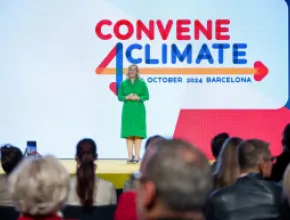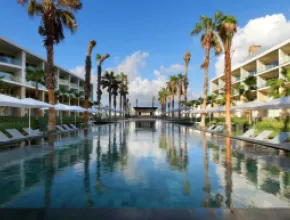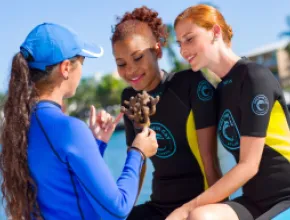Is my meeting “green?“
The meeting industry may finally answer this question when the Accepted Practices Exchange (APEX) launches its standards for best practices for green events. Although, trying to pin down the exact launch date reminds me of one of my favorite sayings: “Everything in the universe is subject to change…and…everything is on schedule.”
Meanwhile, we do know that using fundamental green techniques will be the first step toward proving your meetings are green and sustainable. The proposed standards all require the same basic practices. So it is back-to-basics with these elements. To make it easier, consider the following practices as a checklist of questions:
- Do you recycle? Ask all of your meeting venues and vendors this question. If the answer is yes, ask what they recycle, e.g. paper, glass, cardboard, aluminum, plastic are all options. Then request the amount of recycling be measured (by weight or volume) during your meeting and available to you within 30 days afterward.
- How can you reduce energy and water use? During the RFP process and site inspection ask the facility representative about low-flow toilets and showers, energy efficient lighting and Energy Star equipment, to name just a few. Can they measure the event’s use for you as well?
- What are you buying? Ask yourself, do you absolutely need it? You can save cold, hard cash and the environment by only purchasing essential items. As an example, if you have an electronic version of the conference program and don’t print the 30-page document you handed out last year, how much can be saved in money, trees, energy and water this year?
- Can you buy it in bulk? This question is both for your organization and for your vendors. We know water, condiments and unpackaged food items are both a cost savings and environmental savings. Speaking of packaging, make sure your conference t-shirts and bags don’t have an additional polybag around them.
- Can you find it locally? This is an important question to ask many times during the planning process. Think about local food, local products and gifts made from indigenous artisans. But don’t stop there, how about your labor for exhibit set-up and audiovisual technicians? Even the band for the big gala event can be hired from talent available in the community.
- What is it made of? This question leads us to another series of questions such as, is it made from recycled material, is it petroleum-based or natural and was the laborer paid a living wage? I always caution, “Remember not to purchase giveaways that come from endangered species,” because believe it or not, I have even seen this done.
- Where will it end up? Begin with the end in mind. Can it be composted, recycled or reused? Are there local food banks or organizations you can donate items to? If it is a conference gift, will the participant be able to consume it or will they have to travel home with it? Make sure it is an item they really cherish and make it easy to transport.
- Is it third-party certified or verified? Let others do your work for you. If you determine a venue or vendor is certified by a reputable third-party, you know their performance has been verified. As an example, if we know a hotel has a Green Seal Certification, our checklist can be less rigorous. They have already had to meet clear criteria and report regularly on their environmental performance.
Finally, don’t do all of this work without measuring and documenting. Just like the post-con review of catering bills, hotel invoices and budgets, this step in the process is vitally important. By gathering both your economic and environmental data, you can establish a baseline. Then you will be able to determine your progress producing a sustainable event and document it for key stakeholders. Wait until you tell the boss how much money you saved this year! Don’t forget to share your story with fellow event professionals, too. We are all learning from each other during this process, so sharing your success and challenges is essential.
While sustainability can be made into a very complex issue (and often is), I would like to suggest that by simply asking a few questions during the planning and purchasing processes, meeting planners and suppliers alike would be well on their way to producing sustainable meetings.
 Nancy J. Zavada, CMP, is a leader, innovator and entrepreneur in the meeting planning and events industry and is a principal with MeetGreen, a Portland, Ore.-based conference management and consulting firm that she founded and which specializes in green meetings. Zavada served on the Live Earth Global Green Team and is cofounder of the Green Meeting Industry Council. She is also the coauthor of Saving Green by Going Green, available at www.meetgreen.com. Her blog, “Pretentious Musings of a Meet Green Martyr,” shares resources, tips, ideas and funny stories about the life of a green meeting planner, and can be accessed at http://blog.meetgreen.com. To enquire about purchasing a checklist and other tools for planning a green meeting, contact MeetGreen at info@meetgreen.com.
Nancy J. Zavada, CMP, is a leader, innovator and entrepreneur in the meeting planning and events industry and is a principal with MeetGreen, a Portland, Ore.-based conference management and consulting firm that she founded and which specializes in green meetings. Zavada served on the Live Earth Global Green Team and is cofounder of the Green Meeting Industry Council. She is also the coauthor of Saving Green by Going Green, available at www.meetgreen.com. Her blog, “Pretentious Musings of a Meet Green Martyr,” shares resources, tips, ideas and funny stories about the life of a green meeting planner, and can be accessed at http://blog.meetgreen.com. To enquire about purchasing a checklist and other tools for planning a green meeting, contact MeetGreen at info@meetgreen.com.







